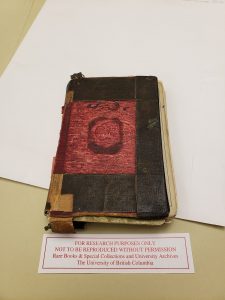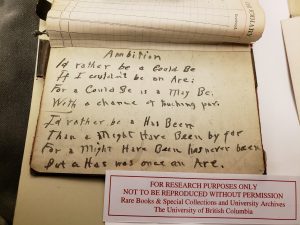The record-keeping nature of archives contributes to “societal memory” (Carter 217). The “traces” left behind by people residing in that “society” is what is preserved in archival memory (Carter 220). Another notable abstract of archival activities is forming an “identity” (Carter 221). According to Villar, many take up the form of writing in order to create an identity so as to not be forgotten (503). While almost all archival documents do the work of both, this blog will particularly focus on how a journal acts as a type of medium to convey these abstracts and will particularly refer to the journal kept by a World War I soldier, John Moses Stickney or, better addressed as Jack Stickney.
Below I attached a picture of what the exterior of Stickney’s diary looked like. As you might see, it is a really small compact one. In the context of the deadliest war in history, one might wonder how did anyone have enough state of mind to make everyday entries in pages that barely would fit a hundred words and why. O’Toole and Carter argue that archives can “create” what an oral narrative might not (235; 222). That the narrative will be forgotten if it is not “created and kept” (Carter 222). Hence, we can look at Stickney’s diary keeping as a form of creation of archival material in order to be remembered. This we can see as creating “memory” and forming and leaving behind an “indentity”.

At the end of his diary, he wrote what seemed like a poem under the headline “Ambition”. It read:
“I’d rather be a Could Be
If I couldn’t be an Are;
For a Could Be is a May Be;
With a chance at touching par.
I’d rather be a Has Been
Than a Might Have Been by far
For a Might Have Been has never been
But a Has was once an Are” (Stickney).

I read this as Stickney’s attempt at escaping “marginalization” and having a strong “voice” in being remembered (Carter 224). As far as I could read into it, it looked as if Stickney did not just want to be added to the list of the millions who died in his time or would die a time after his passing. I speak of Sitckney being “marginalized” (Carter) in the sense that had his documents not been contributed to the archives, he would just be one of the many souls that lost their lives, perhaps only a name in soldier book keeps or similar military documents such as that. According to O’Toole, an archive can hold both “practical” and “symbolic values.” By “practical values” he means simply the record keeping of history, for example, Stickney might have his name recorded in the “Military Service Records” of World War I. “Symbolic values” refer more to the details going deeper than just the obvious (238). In this case, the diary not only shows that a Jack Stickney did exist but also gave an effort to leave a mark in the world behind. This is how Stickney’s diary creates a “societal memory” (Carter 220) and “indentity” (Carter 221) in the minds of the people in the present.
Overall, the aim of this blog was not only to specify what significance a simple personal thing such as a diary holds as an archive but also to encourage a range of views, the stretch of narratives one document may hold and the importance of noticing them so that any “gaps” (Carter 217) in the knowledge can be identified and redressed for.
Work Cited
Carter, Rodney G.S. “Of Things Said and Unsaid: Power, Archival Silences, and Power and Silence”. Archivaria 61, pp. 215-233.
O’Toole, James. “The Symbolic Significance of Archives”. The American Archivist, Vol. 56, No. 2 1993, pp. 234-255, Society of American Archivist, https://www.jstor.org/stable/40293731? seq=1&cid=pdf-reference#references_tab_contents
Stickney, John Moses. Stickney Papers. Diary. 1-17. Jack Stickney Fonds. University of British Columbia Library Rare Books and Special Collections, Vancouver, Canada.
Villar, Marilia Santanna. “Archives of memory – or Your diary in good hands”. Universidade Federal do Rio de Janeiro, http://www.scielo.br/scielo.php?script=sci_arttext&pid=S1517-106X2016000300501&lng=pt&tlng=pt
